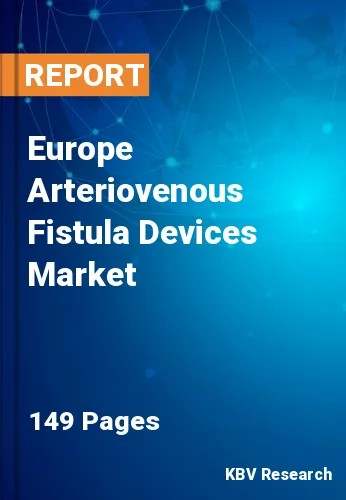The Europe Arteriovenous Fistula Devices Market would witness market growth of 6.7% CAGR during the forecast period (2023-2030).
The blood enters a dialysis machine through tubes from the body during hemodialysis. The blood is cleaned by eliminating some waste and surplus fluid while it is in the machine by passing through a filter known as a dialyzer. After that, tubes from the dialysis machine transport the cleaned blood back into the body. There are several ways to access hemodialysis, including central venous catheters (CVC), arteriovenous fistulas (AVF), and arteriovenous grafts (AVG). AVF, as well as AVG, are recommended due to a lower likelihood of infection. Regarding the primary as well as secondary patency rates, AVF has a benefit over AVG.
Arteriovenous fistula devices are also necessary for maintenance and monitoring. This is due to the potential consequences that an arteriovenous fistula may bring about if left untreated. There could be some serious consequences. Large arteriovenous fistulas can lead to significant complications like heart failure. Compared to regular blood veins, an arteriovenous fistula allows blood to flow more swiftly. To move more blood through the body, the heart needs to work harder than usual. Heart failure may eventually result from the strain on the heart.
In England, the National Health Service (NHS) spent approximately £1.45 billion on CKD in 2009–10, or £1 for every £77 spent by the NHS. The greatest rates of high blood pressure among EU nations were found in Croatia (37% of those over the age of 15), Latvia (32%), and Hungary (32%). In the EU, significantly more women than men reported having high blood pressure in 2019. Croatia, Latvia, and Hungary had the greatest percentages of women with high blood pressure. However, men in Croatia, Hungary, and Finland had a significantly higher prevalence of high blood pressure than men in any other country. Thus, the increasing instances of hypertension and CKD result in more people requiring hemodialysis. Therefore, the demand for AVF devices is estimated to rise in the coming years.
The Germany market dominated the Europe Arteriovenous Fistula Devices Market by Country in 2022, and would continue to be a dominant market till 2030; thereby, achieving a market value of $33.3 million by 2030. The UK market is poised to grow at a CAGR of 5.8% during (2023 - 2030). Additionally, The France market would witness a CAGR of 7.5% during (2023 - 2030).
Based on End-use, the market is segmented into Hospitals, Ambulatory Surgical Centers and Dialysis Centers. Based on Type, the market is segmented into AVF Creation Devices (Surgical Instruments, Vascular Grafts, Angioplasty Balloons and Others), AVF Monitoring Devices (Doppler Ultrasound, Pressure Monitoring Systems, and Others) and AVF Maintenance Devices (Central Venous Catheters, Stents and Others). Based on countries, the market is segmented into Germany, UK, France, Russia, Spain, Italy, and Rest of Europe.
Free Valuable Insights: The Worldwide Arteriovenous Fistula Devices Market is Projected to reach USD 521.9 Million by 2030, at a CAGR of 6.9%
The market research report covers the analysis of key stake holders of the market. Key companies profiled in the report include Medtronic PLC, Becton, Dickinson and Company, Teleflex, Inc., Fresenius Medical Care AG & Co. KGaA. (Fresenius SE & Co. KGaA), B. Braun Melsungen AG, Poly Medicure Ltd., Asahi Kasei Corporation, Laminate Medical Technologies Ltd., Cook Medical, Inc. (Cook Group), and Boston Scientific Corporation
By End-use
By Type
By Country
Our team of dedicated experts can provide you with attractive expansion opportunities for your business.

